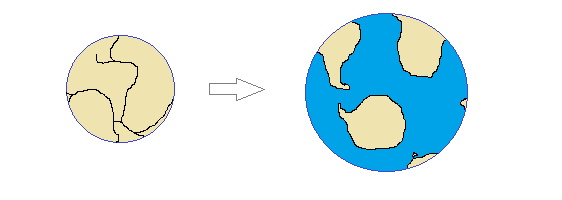The theory of physics that I developed during the summer of 2017 came about as a result of some intriguing problems related to gravity. The enormous size of many dinosaurs indicate that gravity was less strong in their time, and on a related note, Earth seems to have expanded over time, also since the time of the dinosaurs.
 |
| Earth's expansion as seen from the South Pole |
But according to Newton's formulas, an expanding Earth would result in lower surface gravity unless mass has been added. However, very little mass has been added over the eons. There's also the problem of our moon's orbit, which would have been greatly impacted. Our moon would have been drawn closer to Earth. But the opposite is currently the case. Our moon is receding.
All of this combines into a confusing riddle, made all the more confusing by the fact that no-one has a good explanation for what gravity is. I was attracted to various electric explanations, preferring to think of gravity as related to the electric force rather than a curvature of space. However, the electric explanations weren't very convincing either, so I started playing around with various solutions of my own making.
I concluded that there has to be an aether for magnetism, the electric force and gravity to act without direct physical contact.
I was determined to avoid inventing new particles, so I figured the aether had to be a combination of low energy photons and neutrinos, and I was delighted to discover that magnetism can in fact be modelled entirely as a phenomenon related to polarized photons. Then I discovered that the electric force can be modelled as something communicated by neutrinos.
Having discovered early on that the large difference in size between protons and electrons can be explained as the result of a tiny imbalance between positive and negative charge, I realized that gravity too could be a result of this imbalance. However, since I came to this conclusion via an elaborate chain of thoughts, my explanation for gravity ended up rather technical.
Reading about gravity in my books without first reading about stable particles, the aether and the electric force, is confusing. But I'm reluctant to change the chapters because they're accurate and to the point for anyone who've read the preceding chapters. However, for the ones solely interested in my conclusion, gravity can be summed up as the result of a tiny imbalance in the electric force. Electric repulsion is weaker than electric attraction by a tiny factor. Since all matter is made up of electrically charged particles, we end up with an attracting force between neutral bodies, and that force is what we call gravity.
Having found a simple model for what gravity is, other things fell into place. I could explain stability of orbits in terms of gravitational attraction, which acts from the center of bodies, and electric repulsion that acts from the surface of bodies. I had an explanation for how our moon can remain in a stable orbit, even if gravity increases.
 |
| Gravitational attraction and electric repulsion |
Adding to this that gravity may be in part a function of charge, and hence capacitance, I had a solution for how a planet can expand and still increase its surface gravity without any added mass. The original puzzle was solved, and a whole lot of other issues turned out to be explained as well. The overall result is the theory I first presented in late 2017.
This is not to say that I'm convinced that I've found the solution to all problems in physics. What I've found solves all the problems I'm aware of, and this demonstrates that there's at least one alternative explanation to what's presented in standard textbook physics. However, I would be delighted to see others present their own solutions, and the problems related to gravity are good starting points for anyone determined to do so.
No comments:
Post a Comment